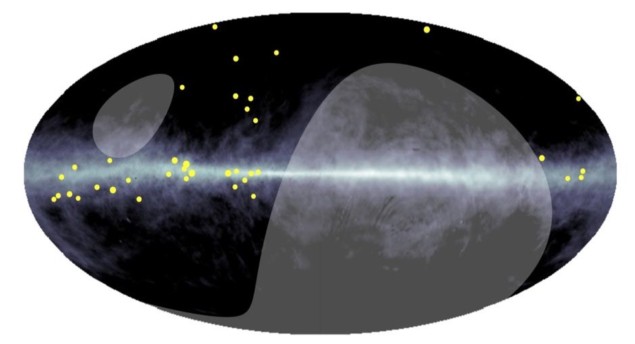
The most energetic gamma ray ever seen could be the strongest evidence yet that high-energy cosmic rays are produced within our Milky Way galaxy, where they spend millions of years accumulating, forming a “cosmic-ray pool”.
The origin of cosmic rays is one of the most enduring mysteries in astrophysics. Cosmic rays are charged particles or atomic nuclei moving at relativistic speeds. While the Sun produces low-energy cosmic rays, the most powerful originate from beyond our solar system, but their source has been a matter of debate.
Cosmic rays are easily deflected by galactic magnetic fields, making it difficult to trace them back to their source. However, when cosmic rays collide with other particles in interstellar space, they result in the production of gamma rays, which are not deflected.
Now, the Tibet ASγ Collaboration, which has hundreds of detectors located on the Tibetan Plateau, has observed 23 extremely high-energy gamma rays, with energies ranging from 400 to 955.7 TeV, the latter being the most energetic gamma ray ever detected. Gamma rays formed in this manner are about an order of magnitude less energetic than their cosmic-ray parents, which means that those cosmic rays reached energies far in excess of one peta-electronvolt (1015 eV). For this reason, the sources of these cosmic rays are referred to as PeVatrons.
This discovery “proves that gamma rays with energies up to a few hundred TeV really exist”, says Jing Huang of the Chinese Academy of Sciences in Beijing, who is a member of the collaboration. It also strongly implies that PeVatrons are located inside our galaxy.

A limit to how far we can see
Astrophysicist David Hanna of McGill University, who was not involved in the work, agrees that “The fact that the arrival directions of most of the gamma rays seem to line up with the Milky Way argues for their production there.”
Hanna does not rule out the existence of extragalactic sources, however, pointing out that there will be observational bias. The higher the energy of gamma ray, the more likely they are able to collide with lower energy photons in space, and therefore space becomes opaque to those higher energies over large distances.
Consequently, “we can’t see as far at high energies as at low energies,” explains Hanna. Many of the higher energy gamma rays from extragalactic PeVatrons may just not be reaching us, although Hanna does note that a few of the gamma rays detected by the Tibet ASγ Collaboration don’t align with the Milky Way. These could be spurious background events, he says, or be truly extragalactic.
Footprints of dinosaurs
Adding to the intrigue is the fact that the distribution of the gamma rays across the Milky Way seems random. Supernovae remnants, intense star-forming regions and active black holes have all been mooted as possible PeVatrons, but none are found in the locations the gamma rays are coming from.
Instead, the team of scientists behind the Tibet ASγ Collaboration think that what they are seeing is evidence for a cosmic-ray pool in our galaxy. The idea is that cosmic rays become contained in our galaxy by the Milky Way’s powerful magnetic fields, and they circle the galaxy for millions of years before coincidentally colliding with an atom or molecule in interstellar space, releasing a gamma ray. These gamma rays could therefore be coming from the locations where a collision has taken place. And by the time they undergo this collision, the original PeVatrons that released the cosmic rays could be long dead.
“Metaphorically speaking, we found footprints of dinosaurs in the Milky Way – a lot of extinct PeVatrons in the galaxy,” says Masato Takita of the Institute for Cosmic Ray Research at the University of Tokyo.

The riddle of ultrahigh-energy cosmic rays
Not all PeVatrons are extinct, however. For example, earlier this year the Tibet ASγ Collaboration detected gamma rays with energies up to 100 TeV originating from the supernova remnant G106.3+2.7, which is just 2600 light-years away.
The next step is to extend the survey of gamma rays into the southern hemisphere sky, including the direction of the galactic centre, which cannot be seen well from Tibet. The Pierre Auger Observatory in Argentina can detect gamma rays with energies of hundreds of TeV and has hunted for gamma rays even more powerful, while the Large High Altitude Air Shower Observatory in China, which has just begun observing, may be able to detect gamma rays with energies above 1 PeV.
The findings are published in Physical Review Letters.



